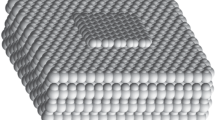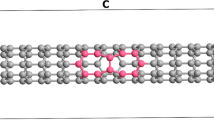Abstract
We report on the research of the stability of partitioned (bamboo-like) carbon nanotubes with different diameters. The stability of the partitioned carbon nanotubes of the smallest diameter were determined by the tight-binding method. For the prediction of the destruction regions of the bamboo-like nanotubes atomic framework subjected to strain the new original method of the calculation of the local stress of atomic network was developed. Using this method it was shown that partitioned carbon nanotubes with a diameter of 2.02 nm are stable. These partitioned carbon nanotubes with chirality (15,15) are the most stable partitioned carbon nanotubes with the smallest diameter.





Similar content being viewed by others
References
Tagmatarchis N (2012) Advances in Carbon Nanomaterials. Science and Applications, Pan Stanford Publishing, pp 1–65.
Suarez-Martinez I, Grobert N, Ewels CP (2012) Nomenclature of sp2 carbon nanoforms. Carbon 50:741–747
Thess A, Lee R, Nikolaev P, Dai H, Petit P, Robert J et al. (1996) Crystalline ropes of metallic carbon nanotubes. Science 273:483–487
Ruland W, Schaper AK, Hou H, Greiner A (2003) Multi-wall carbon nanotubes with uniform chirality: evidence for scroll structures. Carbon 41:423–427
Motta M, Moisala A, Kinloch IA, Windle AH (2007) High performance fibre from “dog bone” carbon nanotubes. Adv Mater 19:3721–3726
Monthioux M, Noe’ L, Dussault L, Dupin J-C, Latorre N, Ubierto T et al. (2007) Texturising and structurising mechanisms of carbon nanofilaments during growth. J Mater Chem 7:4611–4618
Zhu DM, Kisi EH (2010) Preparation and characterization of BNC compounds with cylindrical and bamboo nanotubes. Materials Science Forum 654–656:1146–1149
Zhang L, Chen L, Wells T, El-Gomati M (2009) Bamboo and herringbone shaped carbon nanotubes and carbon nanofibres synthesized in direct current-plasma enhanced chemical vapour deposition. J Nanosci Nanotechnol 9(7):4502–4506
Meng FY, Shi SQ, Xu DS, Yang R (2006) Size effect of X-shaped carbon nanotube junctions. Carbon 44:1263–1266
Tiprigan O, Koós AA, Nemes-Incze P, Horváth ZE, Sárközi Z, Simon S et al. (2007) Obtaining bamboo-structured, multiwalled carbon nanotubes using the spray pyrolysis method. J Optoelectron Adv M 9(3):617–620
Saito Y, Yoshikawa T (1993) Bamboo-shaped carbon tube filled partially with nickel. J Cryst Growth 134:154–160
Wang X, Hu W, Liu Y, Long C, Xu Y, Zhou S et al. (2001) Bamboo-like carbon nanotubes produced by pyrolysis of iron(II) phthalocyanine. Carbon 39:1533–1536
Chen J, Li Y, Ma Y, Qin Y, Chang L (2001) Formation of bamboo-shaped carbon filaments and dependence of their morphology on catalyst composition and reaction conditions. Carbon 39:1467–1475
Dasgupta K, Sen D, Mazumdar T, Lenka RK, Tewari R, Mazumder S et al. (2012) Formation of bamboo-shaped carbon nanotubes on carbon black in a fluidized bed. J Nanopart Res 14(3):1–9
Zhu J, Jia J, Kwong Fl, Leung Ng DH Synthesis of bamboo-like carbon nanotubes on a copper foil by catalytic chemical vapor deposition from ethanol. Carbon 50(7): 2504–12
Banks CE, Davies TJ, Wildgoose GG, Compton RG (2005) Electrocatalysis at graphite and carbon nanotube modified electrodes: edge-plane sites and tube ends are the reactive sites. Chem Commun 7:829–841
Heng LY, Chou A, Yu J, Chen Y, Gooding JJ (2005) Demonstration of the advantages of using bamboo-like nanotubes for electrochemical biosensor applications compared with single walled carbon nanotubes. Electrochem Commun 7(12):1457–1462
Glukhova OE, Kolesnikova AS (2012) Mechanical and emission properties of thinnest stable bamboolike nanotubes. J Phys: Conf Ser 393:0120271
Glukhova OE, Slepchenkov MM (2012) Influence of the curvature of deformed graphene nanoribbons on their electronic and adsorptive properties: theoretical investigation based on the analysis of the local stress field for an atomic grid. Nanoscale 4(11):3335–3344
Yatsuhashi T, Nakashima N (2008) Direct ionization desorption of fullerene by intense femtosecond laser fields. Rev Laser Eng Suppl 36:1000–1003
Sidorov LN (2001) Buckminsterfullerene, higher fullerenes, and their endohedral and fluorine derivatives. Physics of the Solid State 44(3):413–418
Stobinski L, Peszke J, Lin HM (2003) Computational studies of SWCNTs capped by hemispheres of C60 fullerene, based on semiempirical methods. Rev Adv Mater Sci 5:363–370
Glukhova OE, Kolesnikova AS (2011) Empirical modeling of longitudinal tension and compression of graphene nanoparticles and nanoribbons. Physics of the Solid State 53(9):1957–1962
Salter K (1995) Scanning tunneling microscopy of carbon nanotubes and nanocones. Carbon 33:915–920
Iijima S (1993) Growth of carbon nanotubes. Mater Sci Eng B 19:172–180
Acknowledgments
The authors gratefully acknowledge funding of this work by the Russian Foundation for Basic Research No 12-02-00807 and by the Ministry of education and science of the Russian Federation, project 14.B37.21.1094.
Author information
Authors and Affiliations
Corresponding author
Rights and permissions
About this article
Cite this article
Glukhova, O.E., Kolesnikova, A.S. & Slepchenkov, M.M. Stability of the thin partitioned carbon nanotubes. J Mol Model 19, 4369–4375 (2013). https://doi.org/10.1007/s00894-013-1947-0
Received:
Accepted:
Published:
Issue Date:
DOI: https://doi.org/10.1007/s00894-013-1947-0




